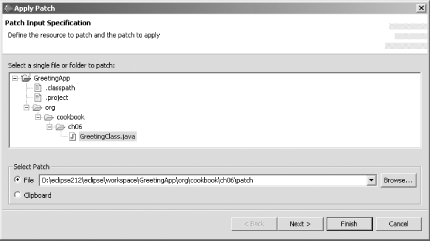6.11.1 Problem You need to coordinate your development with another team of developers using a patch they can install to update their code. 6.11.2 Solution Create a code patch so that they can update their code. (Note that this is a code patch , not a binary patch. Eclipse can use this patch to update source code to match another version.) 6.11.3 Discussion Say your version of the code displays the text " No problems here. ": public static void main(String[] args) { System.out.println("No problems here."); }
But the code the other team is using from the CVS repository displays " No problems at all. ": public static void main(String[] args) { System.out.println("No problems at all."); }
To update the other developers without changing version numbers , you can create a code patch. To create a code patch, Eclipse compares your local code to what's in the repository and creates a patch file holding the differences. To create a code patch using your local version of a file as the version to which the patch will update the version in the repository, save your file locally, right-click it, and select Team  Create Patch, opening the dialog shown in Figure 6-12. Create Patch, opening the dialog shown in Figure 6-12. Figure 6-12. Creating a new patch 
In this example, we'll save the file named patch in the current workspace, as shown in Figure 6-12. Click the Finish button to save the patch. This creates the text file named patch . Here's what that file looks like; you can see the line to remove marked with a - and the line to add marked with a + : Index: GreetingClass.java =================================================================== RCS file: c:/repository/GreetingApp/org/cookbook/ch06/GreetingClass.java,v retrieving revision 1.2 diff -u -r1.2 GreetingClass.java --- GreetingClass.java 25 Feb 2004 16:34:07 -0000 1.2 +++ GreetingClass.java 25 Feb 2004 18:12:18 -0000 @@ -17,6 +17,6 @@ public static void main(String[] args) { - System.out.println("No problems at all."); + System.out.println("No problems here."); } }
To apply the new patch to code that has not yet been patched, right-click the file to be updated in Eclipse and select Team  Apply Patch, opening the dialog shown in Figure 6-13. Apply Patch, opening the dialog shown in Figure 6-13. Figure 6-13. The Apply Patch dialog 
Click Next to open the dialog shown in Figure 6-14. In this dialog you can review the changes the patch will create in the local version of the file. As shown in the figure, Eclipse will change the line: System.out.println("No problems at all.");
to: System.out.println("No problems here.");
To apply the patch, click Finish. Figure 6-14. Accepting a patch 
Applying the patch makes this change to the code in the other team's installation of Eclipse, as shown in Figure 6-15. Note that the version number of the file was not changed, but the file was updated with the new code. Figure 6-15. Applying a code patch 
|